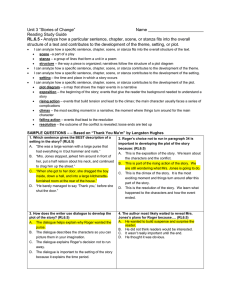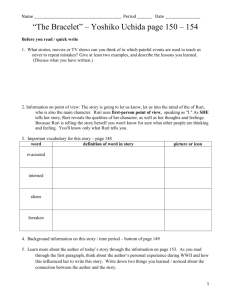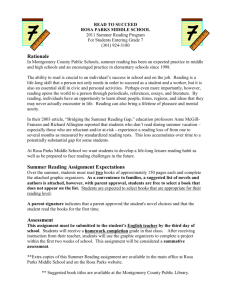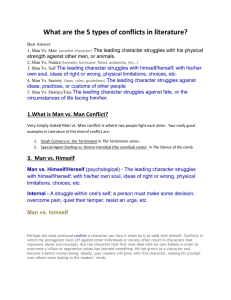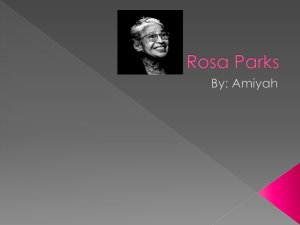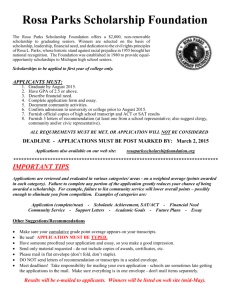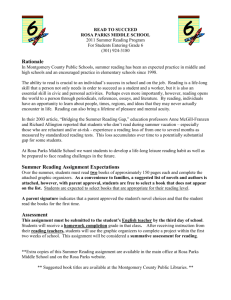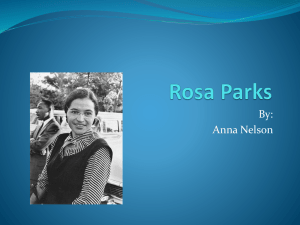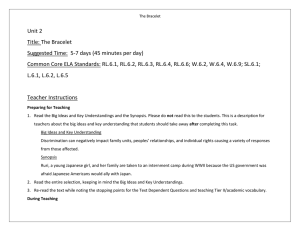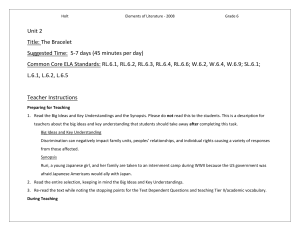Reading Unit 4 Study Guide Name RL.6.6 Explain how an author
advertisement
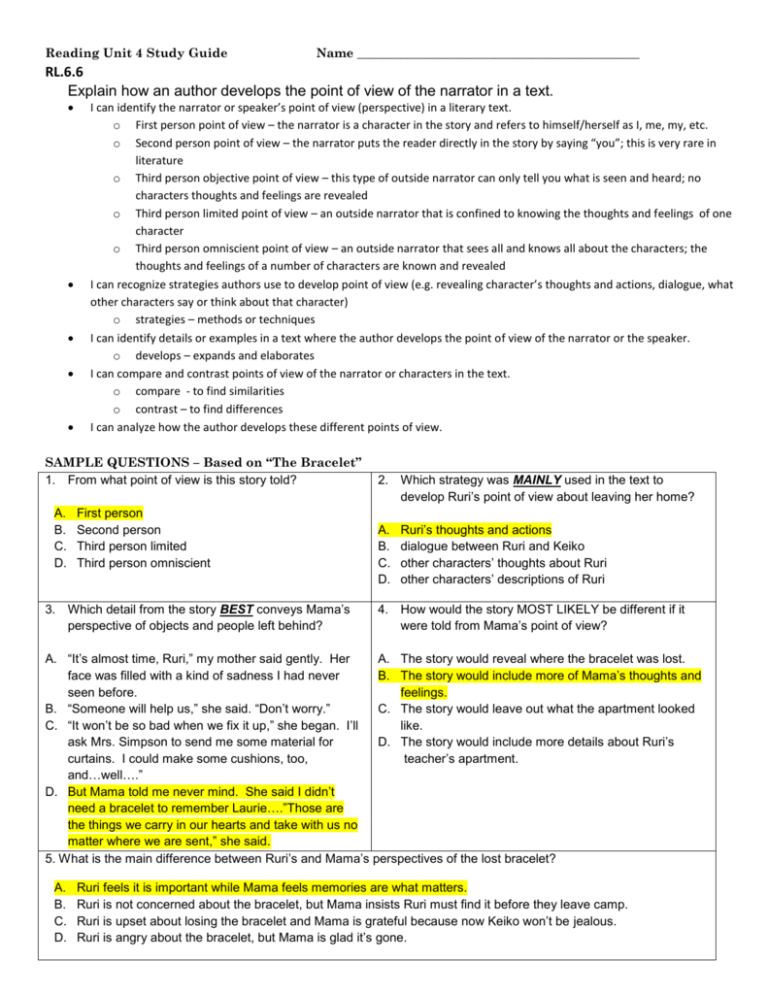
Reading Unit 4 Study Guide Name _____________________________________________ RL.6.6 Explain how an author develops the point of view of the narrator in a text. I can identify the narrator or speaker’s point of view (perspective) in a literary text. o First person point of view – the narrator is a character in the story and refers to himself/herself as I, me, my, etc. o Second person point of view – the narrator puts the reader directly in the story by saying “you”; this is very rare in literature o Third person objective point of view – this type of outside narrator can only tell you what is seen and heard; no characters thoughts and feelings are revealed o Third person limited point of view – an outside narrator that is confined to knowing the thoughts and feelings of one character o Third person omniscient point of view – an outside narrator that sees all and knows all about the characters; the thoughts and feelings of a number of characters are known and revealed I can recognize strategies authors use to develop point of view (e.g. revealing character’s thoughts and actions, dialogue, what other characters say or think about that character) o strategies – methods or techniques I can identify details or examples in a text where the author develops the point of view of the narrator or the speaker. o develops – expands and elaborates I can compare and contrast points of view of the narrator or characters in the text. o compare - to find similarities o contrast – to find differences I can analyze how the author develops these different points of view. SAMPLE QUESTIONS – Based on “The Bracelet” 1. From what point of view is this story told? A. B. C. D. First person Second person Third person limited Third person omniscient 3. Which detail from the story BEST conveys Mama’s perspective of objects and people left behind? 2. Which strategy was MAINLY used in the text to develop Ruri’s point of view about leaving her home? A. B. C. D. Ruri’s thoughts and actions dialogue between Ruri and Keiko other characters’ thoughts about Ruri other characters’ descriptions of Ruri 4. How would the story MOST LIKELY be different if it were told from Mama’s point of view? A. “It’s almost time, Ruri,” my mother said gently. Her A. The story would reveal where the bracelet was lost. face was filled with a kind of sadness I had never B. The story would include more of Mama’s thoughts and seen before. feelings. B. “Someone will help us,” she said. “Don’t worry.” C. The story would leave out what the apartment looked C. “It won’t be so bad when we fix it up,” she began. I’ll like. ask Mrs. Simpson to send me some material for D. The story would include more details about Ruri’s curtains. I could make some cushions, too, teacher’s apartment. and…well….” D. But Mama told me never mind. She said I didn’t need a bracelet to remember Laurie….”Those are the things we carry in our hearts and take with us no matter where we are sent,” she said. 5. What is the main difference between Ruri’s and Mama’s perspectives of the lost bracelet? A. B. C. D. Ruri feels it is important while Mama feels memories are what matters. Ruri is not concerned about the bracelet, but Mama insists Ruri must find it before they leave camp. Ruri is upset about losing the bracelet and Mama is grateful because now Keiko won’t be jealous. Ruri is angry about the bracelet, but Mama is glad it’s gone. RI.6.3 Analyze in detail how a key individual, event, or idea is introduced, illustrated, and elaborated in a text (e.g., through examples or anecdotes). I can identify a key individual. o key individual –an important person or character in a text who appears throughout the text and whom we grow to care about I can identify a key event. o key event – an important and memorable incident I can identify a key idea. o key idea – a main point; an idea that is supported by details throughout the text I can analyze the introduction, illustration, and elaboration of a key individual. o analyze – to examine closely o introduce – to first suggest o illustrate – to provide examples or evidence o elaborate – to go beyond the basic explanation with vivid details and specific explanations I can analyze the introduction, illustration, and elaboration of a key event. I can analyze the introduction, illustration, and elaboration of a key idea. SAMPLE QUESTIONS – Based on " Crusade for Justice“ by Ida B. Wells 6. How does Ida B. Wells introduce the idea that she was treated unfairly on the railroad car? A. by stating that she was sitting in the ladies car as usual B. by describing how the conductor tried to drag her to another car C. by explaining that she bit the conductor when he grabbed her arm D. by showing the reactions of other passengers on the train 7. How does Ida B. Wells elaborate the idea that she refused to change her mind about the lawsuit? A. detailing the her family’s thoughts and feelings B. giving examples of obstacles she overcame to continue the lawsuit C. pointing out that she ended up owing money instead of receiving it D. revealing the Supreme Court’s reasoning for reversing their findings RI.6.6 Determine an author’s point of view or purpose in a text and explain how it is conveyed in the text. I can determine the author’s point of view (perspective). o perspective – way of thinking; viewpoint I can determine the author’s purpose. o author’s purpose – persuade – to convince or to motivate a change inform – to present facts or to explain entertain – to tell a story to provide enjoyment I can explain how the author’s point of view (perspective) or purpose is conveyed in the text (revealed thoughts, feelings, actions, and/or spoken words). SAMPLE QUESTIONS – Based on From “I Was Not Alone: An Interview with Rosa Parks” 8. Which statement from “I Was Not Alone: An Interview with Rosa Parks” BEST shows Parks knew she made the right decision? A “After I stepped up on the bus, I noticed this driver as the same one who had evicted me from another bus way back in 1943.” B. “The decision was made by the three of us, my husband, my mother, and me, that I would go on and use my case as a test case, challenging segregation on the buses.” C. “When I woke up the next morning and realized I had to go to work and it was pouring down rain,, the first thing I thought about was the fact that I never would ride a segregated bus again.” D. “I could feel that whatever my individual desires were to be free, I was not alone. There were many others who felt the same way.” 9. In the excerpt from “I Was Not Alone: An Interview with Rosa Parks,” the different details used by Parks about the events after her decision to file a lawsuit MOST LIKELY reflect – A. Parks’s pride in her family B. Parks’s belief that her decision was personal C. how other people in the community reacted to the bus boycott D. the support she received from her family 10. Short answer - What do Rosa Parks’s words show about her feelings toward freedom? Use evidence from the text to support your ideas. RI.6.9 Compare and contrast one author’s presentation of events with that of another (e.g., a memoir written by and a biography on the same person). I can identify how authors can present information differently based on their perspective (point-of-view). I can compare an author’s presentation of a subject to another author’s presentation of that same subject. I can contrast an author’s presentation of a subject to another author’s presentation of that same subject.(e.g. a memoir to a biography on the same person) SAMPLE QUESTIONS – Based “Crusade for Justice“ by Ida B. Wells and “I Was Not Alone: An Interview with Rosa Parks” 11. Which character trait BEST describes both Ida B. 12. ERQ - Using information from both “Crusade for Justice” by Ida B. Wells and “I Was Not Alone: An Wells and Rosa Parks? Interview with Rosa Parks,” explain how the actions of A. bitter one person can make a difference in the world. B. kind C. surprised D. determined Sample answer rationales: 1. A – “The Bracelet” is told in first person point of view. The story is told by Ruri who is a character in the story. Ruri refers to herself as I, me, my, etc. 2. A – The author uses Ruri’s thoughts and actions to show how she feels about leaving her home and going to the internment camp. Since the story is told by Ruri, the focus is on Ruri. 3. D – Mama’s advice to Ruri at the end of the story shows that Mama feels memories are more important than the objects you have or the people you cannot be with. She knew that Ruri was sad about losing the bracelet and wanted to show her the truly important things to hold on to are in your heart. 4. B – Of course, Mama would reveal her own thoughts and feelings if we were reading the story from her perspective. 5. A - From Ruri’s perspective, the losing the bracelet was terribly important because she had promised Laurie she would never take it off. Mama, however, knew that if Ruri held tight to her memories of Laurie, she would be fine. 6. B – This is the first point in Ida’s narrative that she reveals a mistreatment. 7. B – Ida had to endure a lawyer that was not working for her best interest, she had to pay court costs, her lawyer tried to get her to settle the case. She overcame all of these obstacles and followed her case through to the end. 8. D – Rosa reflected on the other people who shared her views. They joined in with her and she realized that her decision was one that would help create justice in the world. 9. C – Rosa described how people stayed off the bus, how people helped each other get where they needed to be, how a wife told her husband to leave if he didn’t go pick up their cook, how the officials were angry that the rain didn’t cause the boycott to end, how many people (both races) felt more free after the end of segregation, and how many people suffered more than she did. 10. Sample response: Rosa Parks felt freedom was a necessity. “My desires were to be free as soon as I had learned that there had been slavery of human beings and that I was a descendant from them.” This shows that freedom was something Mrs. Parks had needed for a long time. She was willing to take risks to gain freedom, and she knew that change would have to happen if action was taken. I think Rosa Parks was proud of her efforts to gain freedom for everyone. 11. D – Both Ida B. Wells and Rosa Parks showed determination by taking action to end segregation. Their efforts led to great change even though it was not an easy decision. 12. Sample response: Ida B. Wells and Rosa Parks are both women whose actions made a difference in the world. They both helped end segregation in the South. Ida B. Wells made a difference by refusing to move seats on a train. “He tried to drag me out of the seat, but the moment he caught hold of my arm, I fastened my teeth in the back of his hand.” This would have taken a tremendous amount of courage because Ida could have been hurt by the train employees. Ida filed a lawsuit after the incident and went through many hardships.” After months of delay, I found he had been bout off by the railroad.” Many people were against Ida, but she persevered to see that justice was served. Ida B. Wells made a difference to the world by standing up for what she knew was right – equal rights for all people. Rosa Parks made history when she refused to give up her seat on a bus. “When he saw that I was still remaining in the seat, the driver said, “I’m going to call the police and have you arrested.” Rosa refused to move and was arrested for breaking the segregation laws. After making the decision to take her case to court, many changes occurred. “Mass meetings were keeping the morale up. They were singing and praying and raising money in the collection.” Because of Rosa’s actions, people boycotted the buses. Both white people and African Americans realized that change was inevitable. “They thought that my actions didn’t just free blacks but them also.” Because of Rosa Parks, buses were no longer segregated, civil rights were challenged, and changes were made for the good of all. She truly made a difference in the world. Because of these two brave women, the world was changed forever.
